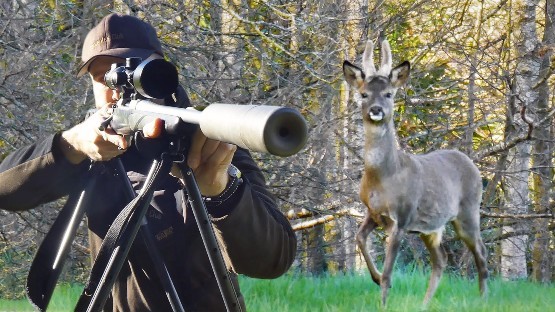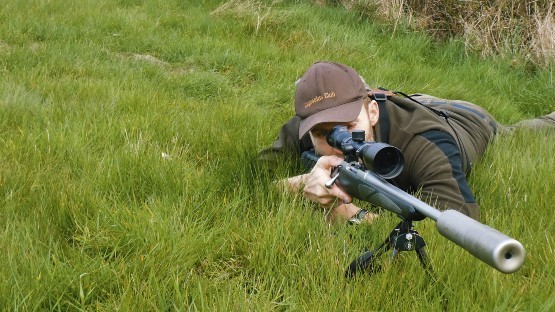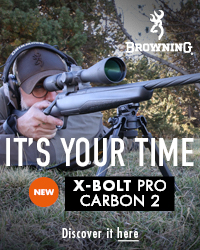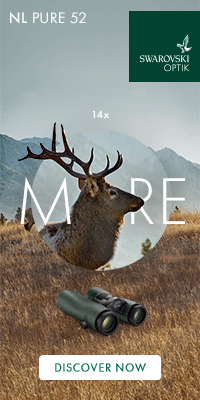It's all about bullet placement in our most recent film: ‘Spine Shot on a Murder Buck’, during which we demonstrate the effect of a spine shot on a Roebuck.

(Above: Professional Stalker Peter Jones takes aim on a Roebuck)
I love this time of year, the sheer opportunity to see deer in the early spring, with the lack of understorey and pressure on the deer to find suitable browse, is perhaps greater than at any other time. However, for the responsible deer manager, with increased opportunity, comes greater responsibility and it’s important to make sure that you are making sound decisions on selection.
So, what is the right Buck?
Well first and foremost, you should aim to shoot those deer which would otherwise have been taken by predators such as the absent Wolf and Lynx. That is to say, the young, weak and infirm.
In a managed cull of bucks, the basic rule of thumb, is that more than half the animals culled should be 'yearlings', in fact my personal choice, is to shoot around 70% yearlings, with the remaining cull being made up of 20% old and just 10% middle age animals in their prime.
As well as being a good time of year to weed out some of these week animals, it’s also a good time for me to take stock of what I have on the ground and this year, it seems that on our County Deer Stalking and Capreolus Club grounds, we have an abundance of animals, leaving me quite literally, spoilt for choice.
With numerous animals exhibiting antlers way over the height of their ears and deserving of being left to mature, or at any rate, to be left until after the rut in late July and early August what exactly should you be looking for?

(Above: Lying prone with a Sako rifle in .308. Peter places a perfect shot at 200 yards)
Well young bucks can have an unsettling impact on the ground and are usually responsible for a disproportionate amount of deer related damage, so its these type of weak heads that you should be culling at the first opportunity. Not only that, but because they are young they also make for some great eating!
During the making of our recent film: ‘Spine Shot on a Murder Buck’, I observed a number of fabulous looking Roebuck during the course of an outing, including a number of excellent heads. Until I finally found a young buck lying down against the bank, offering a perfect shot. However, as I turned the zoom up from my usual 8x to 15 power on my Swarovski Z6i scope, something else grabbed my attention.
(To watch the film now, just follow this link: youtube.com/watch)
I realised that I was not only perfectly positioned for a shot on the yearling, but that in fact I had two shootable animals in front of me. Both the yearling and what we refer to as a Murder buck, exhibiting just two single spikes.
With testosterone levels and sparring between bucks due to commence in a few weeks at the beginning of May, the two spikes exhibited by the Murder Buck will not lock with the antler tines of a rival animal when sparring and may instead be driven into the exposed body of an opponent. The likelihood of this animal injuring other beasts, is therefore quite high. After some short internal deliberation, I therefore shifted my focus to the more pressing matter at hand, the Murder buck, which although more mature was the clear management choice. With that decided I remained keen to also take the youngster so:
In an attempt to take the yearling with a quick follow up shot, I dropped the Murder Buck on the spot at around 200 yards using my Sako rifle in .308, by placing my shot a little higher on the shoulder than usual, casuing an instantly fatal spine shot.
Unlike with traditional ‘Cavity’ or 'Heart/Lung' shot placements, that do not touch the nervous system but cause a strong bleed that results in the deer runing a short distance before dropping, a shot that severs the spinal column will cause the animal to drop instantly on the spot due to an immediate paralysis and usually, instantaneous death.
When combined with a rifle 'moderator' or 'suppressor'', which mitigates the noise heard from the muzzle blast, this choice of shot placement can be a very useful part of a deer hunters repertoire, as it can sometimes mean, that other deer are less alarmed and will remain in the area, allowing the hunter to take a quick follow up shot on another animal.
Regrettably however, on this occasion, it was all too much for the youngster and he was off and away before I got a second opportunity. None the less, I believe that selecting the 'Murder Buck as the priority animal was the sound management choice.
As for the yearling? Well he’ll be there for another day, unless of course he himself makes it through the next few years to become a magnificent mature male.
If you’d like to watch the whole film, you can do so by simply clicking on the following link: “Fatal Spine Shot on a Murder Buck”: youtube.com/watch
To learn more about the best shot placement on deer follow this link: shot-placement-on-deer
Or if you'd like to get out after Roebuck in England and stalk with Peter Jones, then why not email us:



















